Cavazos-Oto: Flexibility domain
Rationale
The purpose of these tests is to gauge passive flexibility in three major movement patterns: “bending over,” “spreading the legs,” and “putting the arms overhead.” These are all functionally important movements in their own right, as well as large-scale articulations requiring good flexibility in a large number of muscles. If your flexibility in other joints or directions (such as ankle flexion) is insufficient for basic tasks, then this is considered pathological, and is beyond the scope of these tests.
Passive flexibility is tested, rather than the somewhat more functional active flexibility, for purposes of isolating the variable. Active flexibility is largely a component of both flexibility and strength, the latter of which is tested for elsewhere.
The bottom end of these rankings is considered the least flexible you can be while still having a basically normal range of motion. The top end is considered the most flexible you can usefully be without excessive laxity. (For instance, a full splits scores a 10 for the second test; if you have oversplits, this is considered non-functional “overkill,” and earns you no further points.)
Guidelines
These may be performed either warm or cold. The former will produce a better score and may be somewhat safer; the latter will yield an “anytime, anywhere flexibility” ranking, which may be more meaningful to you than your post-warmup flexibility. The decision is yours.
Each test consists of two measurements, one to measure flexibility, and one to measure your anthropometry. Since our purpose here is to test the angle your joints can reach, it is necessary to “factor out” limb and torso length, or individuals with long legs, short arms, or the like will register incorrect scores.
To perform these flexibility tests, you will need some sort of rigid straight-edge (such as a stick) and some sort of measuring device (such as a measuring tape). For some tests, a flexible line (such as string or cord) may be used instead of a rigid one, but you will need something rigid at least twice. A yardstick is the most convenient tool for most of these.
Any unit is acceptable, since they will cancel out in the division—your final scores will simply be ratios—but for simplicity and accuracy, millimeters are recommended.
For the second test, you will also need a flat wall of a decent length, with room to stand.
A pen or other marker, plus a helpful assistant, are also recommended.
Test one: Posterior flexibility
This test consists of a “sit and reach,” or pike stretch. It measures the range of motion in hip flexion—chiefly the hamstrings—as well as flexibility of some other posterior muscles, such as spinal erectors and shoulder adductors.
Measurement A
- Lie flat on the ground, body fully stretched, arms down by your sides, arms and legs extended. Mark the point on the floor where the tip of the middle finger of one of your hands (either left or right) touches the ground. Either place a marker (a straight-edge or coin), mark the ground (with chalk or a pencil), or lay down your measuring device, running down the ground alongside your legs, with one end terminating at your fingers.

- Sit up, leaving your legs in the same spot on the ground. Reach forward as far as possible, and mark the farthest point forward you can touch on the ground beside your legs. Again, either place a token, mark the ground, or note where on your yardstick or measuring tape you touched.
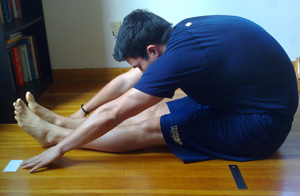
- The distance on the ground in a straight line between the first and second points is your Measurement A.

Measurement B
While standing, torso upright and extended, measure the vertical straight-line distance between the top of your navel (belly button) and the bottom of your clavicle (collar bone) where it protrudes at the sternum. This is your Measurement B.
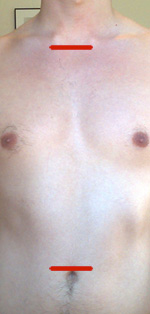
Calculation
Divide Measurement A (your sit-and-reach distance) by Measurement B (your torso height). The result is your posterior flexibility score. A perfect score is 2.6, and will require a nearly-completely closed hip angle.
| Sub-athletic | |||||||||||
|---|---|---|---|---|---|---|---|---|---|---|---|
| 0 | 1 | 2 | 3 | 4 | 5 | 6 | 7 | 8 | 9 | 10 | ranking |
| 0.6 | 0.8 | 1.0 | 1.2 | 1.4 | 1.6 | 1.8 | 2.0 | 2.2 | 2.4 | 2.6 | grads |
Test two: Straddle flexibility
This test is based on a middle- or side-split. It tests the ability of the legs to adduct at the hip with straight knees. It overlaps with, but is distinct from, the posterior flexibility test.
Measurement A
- Stand with your back to a flat, wide wall. You should be upright, with your head, shoulders, butt, and heels all be in contact with the wall.
- Spread your legs into a “splits,” lowering yourself as close to the ground as possible, while keeping contact with the wall at all four points. Your feet may either point forward (wall touching the backs of your heels), or point upwards (wall touching the sides of your feet), as desired. Holding your straight-edge level with the ground, slide it up into your groin until it meets the pelvis. Ignore the phallic imagery.

- Drop a vertical measurement (a yardstick is recommended) from the straight-edge directly to the ground. The distance from the bottom of the straight-edge to the ground is your Measurement A.
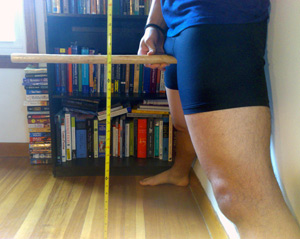
Measurement B
Sitting on the ground with your legs outstretched, measure along the inside of one leg, with knee straight and toes pointing directly upward. The distance from your pubic bone to the farthest point of your heel is your Measure B.
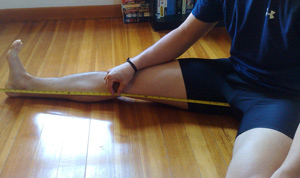
Calculation
Divide Measurement A (the distance from your groin to the ground in a split) with Measurement B (your leg length). The result is your straddle flexibility score. A perfect score will have you on the ground in a full middle splits (A = 0).
| Sub-athletic | |||||||||||
|---|---|---|---|---|---|---|---|---|---|---|---|
| 0 | 1 | 2 | 3 | 4 | 5 | 6 | 7 | 8 | 9 | 10 | ranking |
| 1.0 | 0.9 | 0.8 | 0.7 | 0.6 | 0.5 | 0.4 | 0.3 | 0.2 | 0.1 | 0.0 | grads |
Test three: Shoulder rotation
This test evaluates overall mobility of the shoulder girdle with a “dislocate” or overhead squat-type motion. It assesses the ability of the shoulders to flex while abducted with straight elbows.
Measurement A
- Grasp a stick, pipe, or non-elastic cord in both hands in front of you. For these instructions, we will assume a stick.
- Move one hand to the far end of your stick. Using a pen or pencil, mark the stick where the inside edge of your knuckles rest. This hand is now immobile; it will not move until the test is complete. Your other hand is mobile.
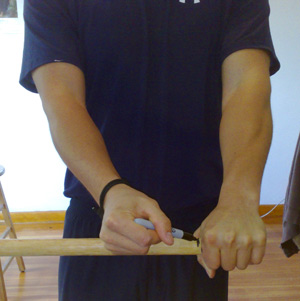
- Place your other hand back on the stick at a comfortable grip and dislocate the stick (rotate it over your head, hands at a constant width and elbows locked, all the way until it touches your lower back, then return it overhead to your front).

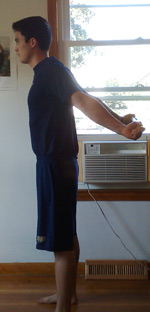
- Move your mobile hand slightly inward on the stick, and repeat the dislocate.
- Repeat Step 4 until you reach a width you are no longer able to dislocate through the full range of motion. Widen your grip back out until you are at a width you can dislocate, but just barely.
- You may now release your non-mobile hand. Mark your stick at the inside edge of your mobile hand’s knuckles.
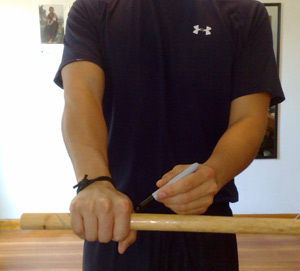
- Measure the distance on your stick between the two marks. This is your Measurement A.

Measurement B
Extend both arms out to your sides, parallel to the ground. Stretch outward as far as you can, letting your shoulder blades extend and holding your elbows, wrists, and fingers straight. Measure a straight line from the tip of your extended middle finger on one hand to the tip of your extended middle finger on the other, straight across your body, parallel to the ground. This is your Measurement B.
(Note: this is a wingspan measurement, and while wingspans are notorious for being very close to one’s height, it is often not identical. For best accuracy, measure this distance.)

Calculation
Divide Measurement B by Measurement A. The result is your shoulder rotation score. A perfect score will have your hands slightly wider than a clean grip.
| Sub-athletic | |||||||||||
|---|---|---|---|---|---|---|---|---|---|---|---|
| 0 | 1 | 2 | 3 | 4 | 5 | 6 | 7 | 8 | 9 | 10 | ranking |
| 1.31 | 1.48 | 1.65 | 1.82 | 2.00 | 2.17 | 2.34 | 2.50 | 2.68 | 2.85 | 3.02 | grads |
Total flexibility score
The below number is the average of the rankings calculated above. Nothing complicated is being done; the numbers output by the above tests are simply being averaged for your convenience. This average is displayed automatically; however, as described in the instructions, your Flexibility score will not be valid until you have completed all of the above tests, even if a number is displayed below prior to that. This is simply a limitation of the calculation widget’s intelligence.
» Flexibility score: «